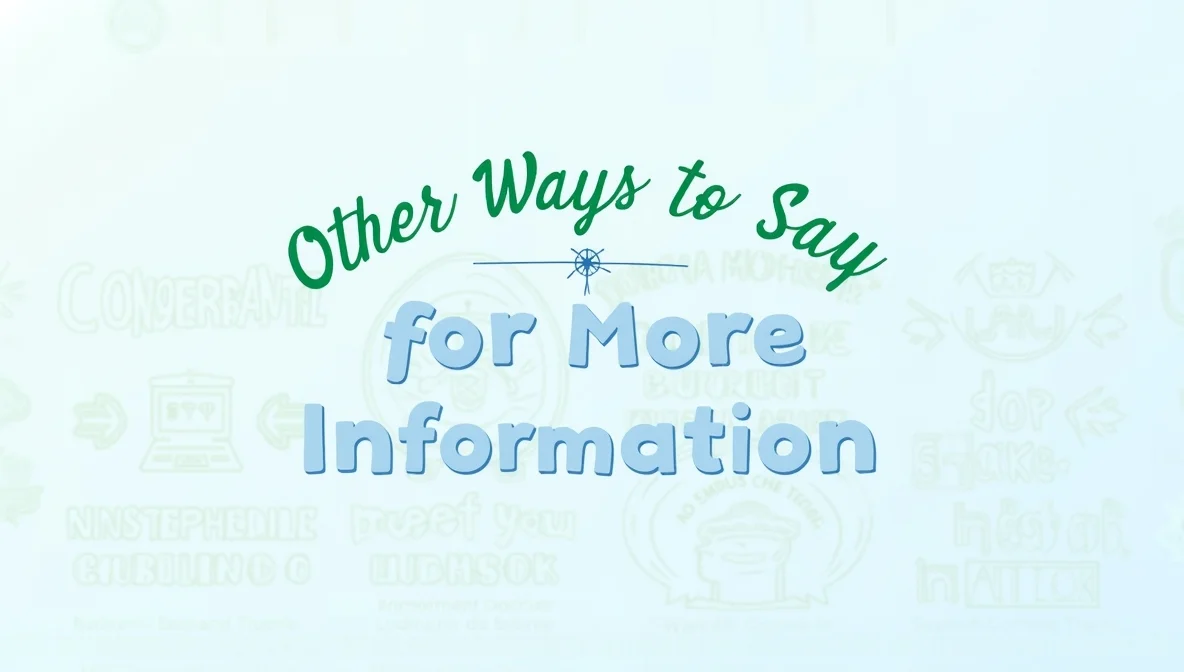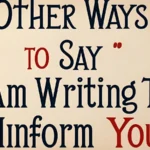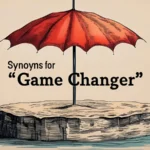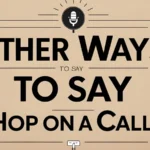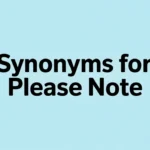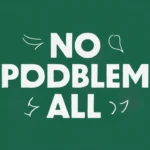In both casual and professional communication, the phrase “for more information” is often used to direct people to additional details. While this phrase is effective, it can become repetitive and predictable. Using synonyms and alternative expressions can enhance the clarity and engagement of your message. Whether you are writing emails, reports, advertisements, or social media posts, diversifying your language makes your communication more compelling. Other Ways to Say “For More Information”.
Choosing the right synonym depends on the tone and purpose of your message. Some alternatives sound formal and authoritative, while others are friendly and inviting. For example, business contexts may require structured phrases like “for further details” or “to learn more,” whereas casual settings may call for expressions like “want to know more?” or “check this out.” By expanding your vocabulary, you create a smoother reading experience and maintain your audience’s interest.
Below, you’ll find different ways to say “for more information,” along with explanations of how to use them effectively.
Find Out More
“Find out more” is a simple and engaging alternative to “for more information.” This phrase works well in various settings, including advertisements, websites, and customer service interactions. It encourages curiosity and invites the reader to explore additional details without sounding too formal or demanding.
In marketing, “find out more” is commonly used in call-to-action statements. For example, a website might say, “Find out more about our latest products here,” which subtly persuades users to click for additional details. The phrase also works well in emails and newsletters when guiding readers to deeper insights.
For informal conversations, this expression keeps the tone light and approachable. If a friend is curious about an event, you might say, “You should check their website to find out more!” This makes the phrase highly adaptable, making it a great alternative to “for more information” in everyday communication.
Read More: Synonyms for “Looks Like”
Learn More
“Learn more” is a widely used alternative that conveys an educational tone. It is especially effective in business, educational, and informational contexts. Whether promoting a product, sharing industry insights, or guiding customers through a process, this phrase invites the audience to deepen their understanding.
Companies frequently use “learn more” on websites, brochures, and social media ads. For instance, a university website may say, “Learn more about our degree programs,” or a business landing page might include a button labeled “Learn more” to direct users to additional content. The phrase naturally encourages exploration without sounding too aggressive or pushy.
This expression also works well in professional emails and reports. Instead of saying, “For more information, refer to the attached document,” you could say, “Learn more in the attached report.” This keeps the message clear and professional while maintaining reader engagement.
Get More Details
“Get more details” is a straightforward and practical phrase that works well in both casual and professional contexts. It implies that additional, specific information is available and encourages the reader to seek it out. This phrase is often used in business communications, event invitations, and customer support messages.
For example, in an event promotion, you might say, “Get more details about the schedule and speakers on our website.” This expression helps clarify that further specifics are available. Similarly, in customer support, a representative might say, “You can get more details about your order status by logging into your account.”
This alternative to “for more information” is also useful in casual conversations. If a friend asks about a new restaurant, you could respond with, “Check their Instagram to get more details on their menu and hours!” The phrase is clear, inviting, and highly adaptable.
Visit Our Website
“Visit our website” is a direct and action-oriented alternative that is especially effective in digital communications. It works well for businesses, organizations, and content creators who want to drive traffic to their online platforms.
For example, a company might say, “Visit our website for the latest updates and promotions.” This expression helps guide customers to an official source where they can find complete and accurate details. It also works well in email marketing, newsletters, and social media posts where linking to additional resources is necessary.
This phrase is particularly useful for customer inquiries. Instead of saying, “For more information, contact us,” a business might say, “Visit our website for FAQs and support options.” This not only provides an immediate solution but also directs the audience to a reliable source of information.
Check This Out
“Check this out” is a casual and engaging way to say “for more information.” This phrase is commonly used in informal settings, social media posts, and friendly conversations. It grabs attention and encourages curiosity, making it a great choice for less formal communication.
For instance, a social media post promoting an article might say, “Check this out – 10 ways to boost your productivity!” This phrase creates excitement and invites the reader to engage with the content. Similarly, in conversations, you can say, “Check this out! I found an amazing new book on personal growth.”
While “check this out” is effective for casual situations, it may not be the best choice for professional or formal settings. In business emails, “learn more” or “find out more” might be a better fit. However, for blogs, marketing, and social media, this phrase adds an energetic and inviting tone.
Discover More
“Discover more” is an engaging and slightly persuasive alternative to “for more information.” It encourages exploration and is often used in advertising, websites, and promotional content.
For instance, a brand might use “Discover more about our new collection” in an email campaign to create curiosity. This phrase works well when you want the audience to take action while maintaining an air of excitement. It’s also commonly used in tourism, such as “Discover more about hidden travel destinations.”
Compared to “learn more,” this phrase adds a sense of adventure and curiosity. It is best suited for situations where you want to spark interest rather than simply provide details. Whether in a business or casual setting, “discover more” is a versatile and engaging choice.
Read More
“Read more” is a direct and functional alternative that is often used in online articles, blogs, and newsletters. It tells the audience that additional written content is available and encourages them to continue reading.
For example, news websites often use “Read more” at the end of an article preview. Businesses may include it in newsletters to guide readers to full articles. It’s also common in e-learning platforms, where a course description might say, “Read more about our advanced training programs.”
This phrase is simple yet effective. It is best used when linking to written content rather than general information. If your goal is to provide more reading material, “read more” is an excellent alternative.
For Further Details
“For further details” is a formal and professional phrase often used in official documents, business emails, and customer service communications. It implies that more in-depth information is available upon request or through a provided source.
For example, an event announcement might say, “For further details, please refer to our official program guide.” In a customer service response, it could be used as “For further details about your account, please contact support.”
This phrase is best suited for professional and structured communication. It ensures clarity while maintaining a respectful and informative tone.
Get in Touch
“Get in touch” is a warm and inviting way to encourage contact or inquiries. It is often used in business, customer service, and networking.
For instance, a company’s website might say, “Get in touch with our support team for personalized assistance.” This phrase adds a friendly and approachable tone while still maintaining professionalism.
Compared to “contact us,” “get in touch” sounds more personal and conversational. It is ideal for businesses that want to build a connection with their customers.
Contact Us
“Contact us” is a widely used alternative in business and customer service. It clearly directs the audience to reach out for assistance, making it effective for websites, emails, and advertisements.
For example, a company might say, “For pricing inquiries, contact us today.” This phrase is direct and easy to understand, making it ideal for formal communication.
It is best used when providing a way for customers or clients to reach out, whether through phone, email, or chat.
Drop Us a Line
“Drop us a line” is an informal and friendly alternative that invites communication. It’s commonly used in customer service, business networking, and casual correspondence.
For example, a freelancer might write, “If you have any questions about my services, drop me a line!” This phrase makes the interaction feel more relaxed and approachable.
While it is great for casual business settings, it may not be suitable for highly formal communication.
Reach Out
“Reach out” is a polite and professional alternative that suggests open communication. It is commonly used in business emails and customer service settings.
For instance, an HR representative might write, “Feel free to reach out if you have any concerns about your application.” This phrase adds a welcoming tone while maintaining professionalism.
It is best used in business contexts where you want to encourage dialogue without sounding too formal.
More Info Available
“More info available” is a concise and practical phrase often used on websites, brochures, and announcements. It tells the reader that additional information exists without being too wordy.
For example, a product description might end with, “More info available on our website.” This keeps the message clear and to the point.
It is best for brief communications where space is limited, such as social media captions or headlines.
Want to Know More?
“Want to know more?” is an engaging and conversational alternative that works well in marketing and informal settings. It directly invites curiosity and encourages action.
For example, a coaching business might use, “Want to know more about our programs? Let’s chat!” This phrase makes the reader feel personally invited to learn more.
It is best used when trying to create engagement and interaction rather than just providing information.
Visit This Page
“Visit this page” is a practical alternative often used in online content and customer support. It directly guides the reader to a specific source for additional details.
For example, an FAQ section might say, “Visit this page for troubleshooting steps.” This phrase ensures clarity and directs users efficiently.
It is best suited for digital content where a link or webpage is available for reference.
Explore More
“Explore more” is a creative and engaging alternative that works well in marketing, travel, and entertainment. It encourages curiosity and discovery.
For example, a travel website might say, “Explore more destinations perfect for your next vacation.” This phrase makes learning about something feel like an adventure.
It is best for industries where excitement and exploration are part of the message.
More Information Here
“More information here” is a straightforward alternative that is commonly used in signs, announcements, and web pages. It directs the audience to a specific place where details can be found.
For example, a conference registration page might say, “More information here about ticket pricing.” This phrase ensures clarity without unnecessary wording.
It is best used in direct communication where a clear reference point is available.
Click Here for Details
“Click here for details” is commonly used in digital content, marketing, and online forms. It provides a clear call to action while keeping things simple.
For example, an online advertisement might say, “Click here for details on our latest deals.” This phrase works well when guiding users to additional content.
It is best used when a clickable link or button is involved.
Need More Info?
“Need more info?” is a friendly and engaging alternative that invites the audience to inquire further. It works well in customer service, marketing, and social media.
For example, a brand might post, “Need more info? DM us anytime!” This phrase creates an interactive and inviting tone.
It is best suited for casual and approachable communication.
Refer to the Following
“Refer to the following” is a precise and structured alternative often used in formal writing, reports, and instructional materials. It directs the reader to specific content, ensuring clarity and professionalism.
For example, a business report might state, “Refer to the following sections for a detailed breakdown of financial performance.” This phrase works well in academic writing, manuals, and official documents where specific references are needed.
It is best used in structured and professional communication, where clear directions are essential. By using “refer to the following,” you provide a logical transition to additional details without sounding repetitive or vague.
Conclusion
Expanding your vocabulary with different ways to say “for more information” makes your communication more engaging, clear, and appropriate for various settings. Whether you need a formal, casual, or persuasive tone, choosing the right phrase enhances your message.
From professional options like “for further details” to conversational alternatives like “check this out,” each phrase has its unique role. Using varied expressions helps maintain reader interest, making your content more dynamic and effective.
By incorporating these synonyms into your writing, you create stronger connections with your audience while keeping your language fresh. Next time you need to direct someone to more details, try one of these alternatives to keep your message engaging and impactful.
